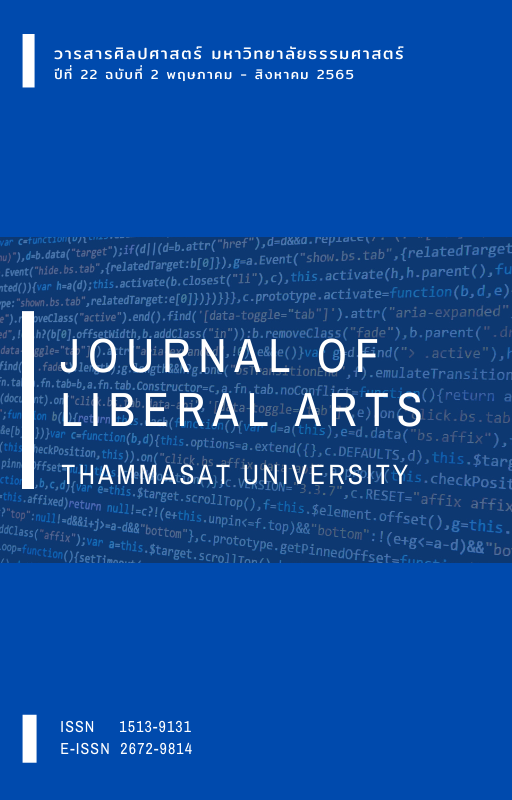Two Decades of Adaptation of the Soi Phiphat 2 Community in the Silom Commercial Area
Main Article Content
Abstract
The objectives of this research are to study the adaptation and community resilience factors of the Soi Phiphat 2 community to disturbances as well as to analyze the change of community land use over a period of 20 years, from 1999 to 2020. Additionally, community strengths, weaknesses, and opportunities are evaluated. This research used mixed methods which included using GIS to analyze land use change combined with in-depth interviews and informal interview methods to identify indexes of community resilience. Participants of this research were 10 people who have been living in the community for more than 20 years. The research shows that there is an increase of 4.46% of residential area and 2.30% of commercial area. Major disturbances of the community are foreign workers moving-in, new generations moving-out, the high cost of living, drugs, traffic congestion, and some environmental problems. As a result of an analysis of local responses to multiple challenges and disturbances, six dimensions of community resilience were found. These dimensions are infrastructure and support services, active agents, social network and support, beliefs, engaged governance and private sectors, and embracing differences and changes. However, there are still some deficiencies which need to be improved to be more resilient, i.e., the lack of interaction and communication between local people and newcomer foreign workers.
Downloads
Article Details

This work is licensed under a Creative Commons Attribution-NonCommercial-NoDerivatives 4.0 International License.
References
กมลรัตน์ บำรุงตน. (2546). การใช้ประโยชน์ที่ดินและการให้บริการโครงสร้างพื้นฐานในย่านพาณิชยกรรมศูนย์กลางกรุงเทพมหานคร: กรณีศึกษาย่านสีลมสาทร [วิทยานิพนธ์ปริญญามหาบัณฑิต]. จุฬาลงกรณ์มหาวิทยาลัย.
ชีวารัตน์ กลับคุณ. (2550). แนวทางการพัฒนาพื้นที่บริเวณย่านธุรกิจสีลมช่วงถนนคอนแวนต์ถึงถนนนราธิวาสราชนครินทร์ [วิทยานิพนธ์ปริญญามหาบัณฑิต]. จุฬาลงกรณ์มหาวิทยาลัย.
บัณฑิต จุลาสัย, เทิดศักดิ์ เตชะกิจขจร, และ พีรศรี โพวาทอง. (2549). โครงการแผนที่บริเวณกรุงเทพฯ พ.ศ. 2450-พ.ศ.2475: การรวบรวมและจัดระบบฐานข้อมูลเพื่อการศึกษาสถาปัตยกรรมและเมืองกรุงเทพ. สำนักงานกองทุนสนับสนุนการวิจัย.
https://elibrary.trf.or.th/project_content.asp?PJID=RDG49H0003
โรงเรียนธุรกิจอสังหาริมทรัพย์ไทย. (2560). ราคาประเมินที่ดินใหม่ สีลม สาทร ทองหล่อ สุขุมวิท เจริญกรุง 2560. https://www.trebs.ac.th/th/news_detail.php?nid=87
ศิวกร สว่างศรี. (2559). การจัดการการเปลี่ยนแปลงภูมิทัศน์วัฒนธรรม: กรณีศึกษา ชุมชนเกาะศาลเจ้า เขตตลิ่งชัน กรุงเทพมหานคร [วิทยานิพนธ์ปริญญามหาบัณฑิต]. จุฬาลงกรณ์มหาวิทยาลัย.
สมฤทัย เล็กศรีสกุล. (2544). แนวทางการออกแบบเพื่อการประสานระบบพื้นที่โล่งในเมืองย่านธุรกิจถนนสีลม [วิทยานิพนธ์ปริญญามหาบัณฑิต]. จุฬาลงกรณ์มหาวิทยาลัย.
สามย่านมิตรทาวน์. (2563). จุฬาฯ-สามย่าน ติด 16 ย่านสุดคูลระดับโลก. https://www.samyan-mitrtown.com/2020/10/08/จุฬาฯ-สามย่าน-นั่งอันดับ/
อมรรัตน์ กล่ำพลบ. (2545). ผู้อยู่อาศัยกับโอกาสในการพัฒนาที่ดินราชพัสดุชุมชนซอยพิพัฒน์ 2 เขตบางรัก กรุงเทพมหานคร [วิทยานิพนธ์ปริญญามหาบัณฑิต]. จุฬาลงกรณ์มหาวิทยาลัย.
Ahmed, I. (2016). Building resilience of urban slums in Dhaka, Bangladesh. Procedia-Social and Behavioral Sciences, 218, 202-213.
Amundsen, H. (2012). Illusions of Resilience? An Analysis of Community Responses to Change in Northern Norway. Ecology and society, 17(4), 46.
Béné, C., Wood, R. G., Newsham, A., & Davies, M. (2012). Resilience: new utopia or new tyranny? Reflection about the potentials and limits of the concept of resilience in relation to vulnerability reduction programmes. IDS Working Papers, 2012(405), 1-61.
Buikstra, E., Ross, H., King, C. A., Baker, P. G., Hegney, D., McLachlan, K., & Rogers‐Clark, C. (2010). The components of resilience—Perceptions of an Australian rural community. Journal of Community Psychology, 38(2), 975-991.
Carter, H. (1990). Urban and rural settlements. Longman.
Chelleri, L., Waters, J. J., Olazabal, M., & Minucci, G. (2015). Resilience trade-offs: addressing multiple scales and temporal aspects of urban resilience. Environment and Urbanization, 27(1), 181-198.
Chirisa, I., & Mabeza, C. (2019). Community Resilience Under the Impact of Urbanisation and Climate Change: Cases and Experiences from Zimbabwe. Langaa Rpcig.
Frankenberger, T., Mueller, M., Spangler, T., & Alexander, S. (2013). Community resilience: Conceptual framework and measurement feed the future learning agenda. Westat.
Haggard, R., Cafer, A., & Green, J. (2019). Community resilience: A meta-study of international development rhetoric in emerging economies. Community Development, 50(2), 160-180.
Magis, K. (2010). Community resilience: An indicator of social sustainability. Society and Natural Resources, 23(5), 401-416.
Murphy, B. L. (2007). Locating social capital in resilient community-level emergency management. Natural Hazards, 41(2), 297-315.
Nelson, D. R., Adger, W. N., & Brown, K. (2007). Adaptation to environmental change: contributions of a resilience framework. Annual review of Environment and Resources, 32, 395-419.
Ross, H., Cuthill, M., Maclean, K., Jansen, D., & Witt, B. (2010). Understanding, Enhancing and Managing for Social Resilience at the Regional Scale: Opportunities in North Queensland. The University of Queenland.
USAID. (2012). Building resilience to recurrent crisis: USAID policy and program guidance. United States Government.
Walker, B., Holling, C. S., Carpenter, S. R., & Kinzig, A. (2004). Resilience, adaptability and transformability in social–ecological systems. Ecology and society, 9(2). [online]. http://www.ecologyandsociety.org/vol9/iss2/art5
Wright, A. (1999). Twentieth Century Impressions of Ceylon: Its History, People, Commerce, Industries, and Resources: Asian Educational Services.

